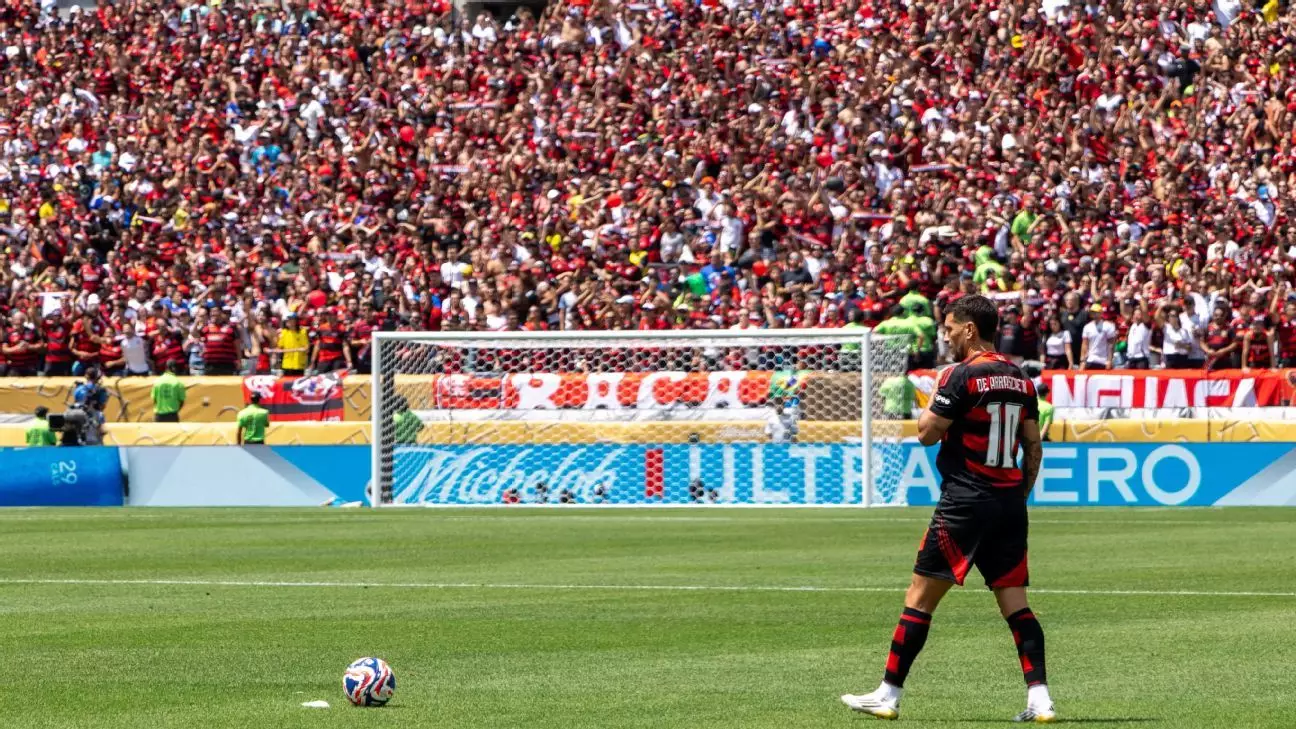The FIFA Club World Cup has evolved into a prestigious stage for clubs to showcase their talents on a global platform, and Brazil, with its rich football heritage, is making strong overtures to host the next edition in 2029. As the inaugural 32-team tournament unfolds, it is becoming increasingly apparent that Brazil’s unique football culture is a perfect match for such a high-profile event. The excitement surrounding this tournament underscores a deeper narrative: the heart and soul of South American football, embodied by passionate fans and iconic clubs, is very much alive and kicking.
However, a critical examination of this year’s tournament reveals both its charm and its tribulations. While the introduction of more teams has the potential to increase competitiveness, it has also led to issues such as sparsely attended matches and interruptions caused by extreme weather conditions. These growing pains may very well cast a shadow on FIFA’s ambitious vision. Yet, the South American clubs, particularly those from Brazil and Argentina, have injected much-needed vitality into the competition, proving that it can indeed thrive.
The Resilience of South American Teams
The South American representation has been a resounding success, breathing life into what might have been a forgettable tournament. The fervor from fans, particularly those who traveled from Brazil and Argentina, has transformed stadiums into vibrant cauldrons of noise and energy. With one round of group matches remaining, the momentum is undoubtedly in favor of these clubs. As it stands, all four Brazilian teams are ruling their respective groups, with only River Plate from Argentina joining the upper echelons. Even Boca Juniors, although not as successful, are performing beyond expectations, consistently showcasing their commitment on the field.
What has made the South American teams stand out is not just their skill but also their potent blend of pride and strategy. Upsets have been plentiful, such as Botafogo’s dramatic triumph over PSG, a match that completely defied pre-game speculations. Such performances have served to agitate the football establishment that often views South American football through a narrow lens.
The Cultural Significance of the Club World Cup
The Club World Cup serves as more than just a competition; it represents an opportunity for South America to reclaim its place in the football world. Historically, the continent has been on the back foot compared to Europe, especially given the unfavorable scheduling of other international competitions like the Intercontinental Cup, which almost always favors European teams. This current iteration, however, allows South American clubs to compete at their peak, being slap dab in the middle of their domestic seasons.
Fans, too, feel this palpable shift. Where once they might have approached a tournament with trepidation, they now exude confidence and enthusiasm, with stadiums echoing the cheers of thousands of expectant supporters. Beyond the matches themselves, what people are witnessing is a cultural reaffirmation of their football identity as the clubs and their fans rally together to inspire each other.
The Teams and Their Tactical Mastery
While teams like Flamengo and Palmeiras are fulfilling expectations, both maintain a cautious respect for the game. Flamengo, having flirted with elimination early on, has found a strong foothold under coach Filipe Luis, especially with the strategic addition of midfielder Jorginho. His ability to dictate the game can tip the scales in their favor. Palmeiras, notorious for making high-profile signings, is not to be overlooked. Striker Vitor Roque, who ranks among Brazil’s priciest transfers, is part of a well-crafted game plan orchestrated by Abel Ferreira, whose tactical acumen is reminiscent of the esteemed José Mourinho.
Botafogo, meanwhile, is redefining expectations. Their disciplined approach against arguably the strongest club team in the world, PSG, highlighted the evolution of Brazilian football from mere “Carnaval” soccer to a more tactical, defensive discipline. Not only did they survive the match with a monumental victory, but they introduced a new narrative: Brazilian football is not just about flashy plays; it can be composed and strategic as well.
Challenges Ahead
As the knockout stages loom, the stakes are higher than ever for the South American clubs. There remains considerable uncertainty, particularly for teams such as Palmeiras, who may now contend with fatigue due to the harsh conditions of the Pasadena heat. The strategy they adopt moving forward will be critical as they aim to avoid pitfalls — like falling victim to Messi’s Inter Miami. River Plate also faces turbulence, compounded by potential suspensions that will test their adaptability against a formidable Inter team.
In these critical moments, fans will rally behind their teams, breathing hope and determination into their efforts. The South American teams enter this tournament not just to participate but to symbolize resilience, pride, and the undying spirit that characterizes football on their continent. With Brazil eyeing a future as a host, there’s a collective sense that this may be a turning point, leading to greater accolades and recognition on the world stage. As the competition unfolds, the beautiful game seems poised for an exhilarating showcase of talent and passion, embodying what truly makes football a global phenomenon.


Leave a Reply